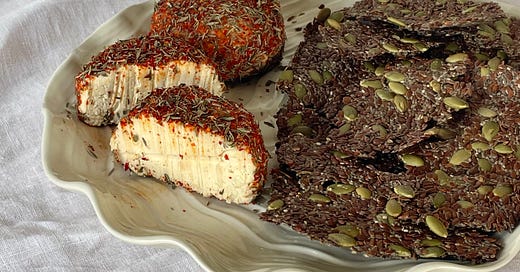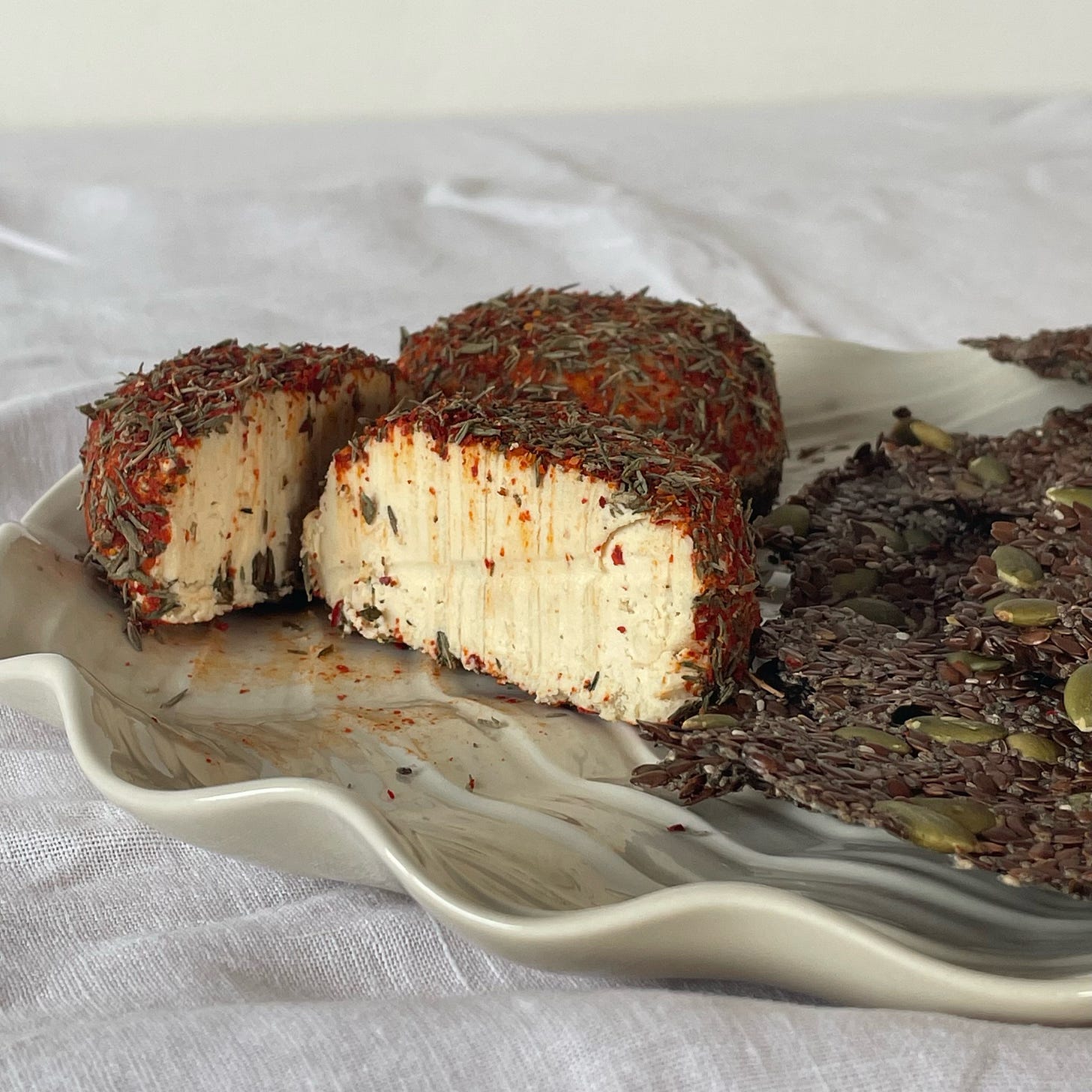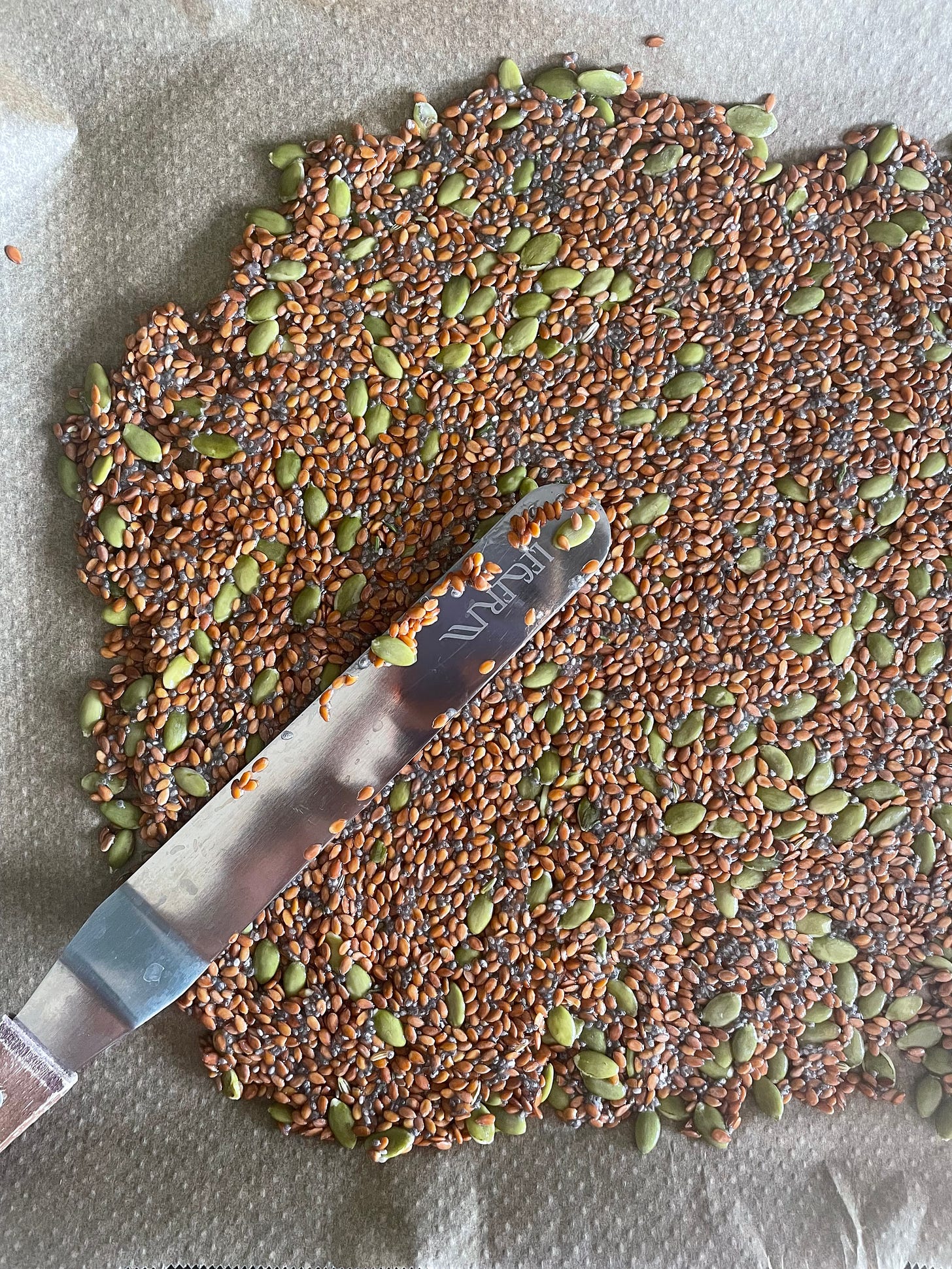Cultured cashew cheese & seeded crackers
So, so tasty and as luck would have it, really good for you.
Nothing can ever replace cheese - but, if you’re looking for a dairy-free alternative that’s almost there, this is it.
There are myriad iterations out there for homemade nut and/or seed cheese, although many share a similar core technique: you soak your nuts/seeds then blitz them up with a liquid to turn into a paste. Cashew nuts are generally the preferred main ingredient, since they blitz up really smooth; if you want a softer cheese or a spread, you’ll add your seasonings and stop there. If you’re aiming for a hard cheese, you’ll dehydrate it. Ensuring there’s some fermented component is the trick to achieving that cheesy, funky flavor. The easiest way of accomplishing that is by adding a raw, already-fermented ingredient - such as gherkin, kraut, or kimchi brine and leaving it to continue fermenting for a couple of days.
A few other key seasonings should help you attain a distinctly savory, umami flavor - things like nutritional yeast, garlic powder, onion powder, and even miso paste! And as with all ferments, the flavors are infinitely adaptable.
Adding live bacteria cultures to a recipe, as opposed to letting them develop over time, is called “culturing”.
In a commercial operation, particular bacteria strains are added under highly controlled conditions. But when you’re fermenting at home, all you need is the brine or a little bit of an already-live ferment. You can apply this technique to virtually any recipe, especially things like sauces or condiments which call for an acidic ingredient - just replace it with your tangy fermented element, and you’ll get a ‘cultured’ version which contains plenty of healthy probiotics. This not only saves time fermenting, it’s low-waste, too: you can put any leftover lactic acid fermentation brine to very good use! It can also be a safer option since you’re adding the good bacteria strains straight into your ferment, which means they’ll be the dominant microbes from the get-go.
I drew inspiration from Pascal Baudar, a fermentation & foraging expert, for this recipe. I like a semi-hard cheese, so I dehydrate my cashew paste by wrapping it in tea towels and putting a weight over it so the fabric absorbs some of the moisture. After about two days at room temp (during which the ‘cheese’ also continues to ferment), I shape the mix into two thick disks, coat them in some dried herbs, spices, and salt, then place in the fridge for about 3 more days so it can dry out. You could push the fridge time even longer for a harder cheese - don’t be afraid to experiment!
I like to pair cashew cheese with seeded crackers, a deceptively simple recipe inspired by my friend Mariana who’s into health foods that also taste delicious. Linseeds (flaxseeds for the Americans) and chia seeds are soaked in water until they go goopy - down to the mucilaginous fiber they both contain - which makes them bind into a sort of goopy paste that’s spreadable. I add some pumpkins seeds and seasonings, then spread the mix flat onto a baking sheet and bake in the oven.
This combo usually gets served at my fermentation classes, and most recently at my last & the Table luncheon. It’s a highly impressive snack to serve up, and surprisingly easy, I promise.
Cultured Cashew Cheese
Makes 2 small cheeses
Ingredients
175g cashew nuts
110-130g ferment brine (from sauerkraut, kimchi, or pickles of any kind, just make sure it’s LIVE and RAW!)
2 tbsp nutritional yeast
Onion powder (optional)
Garlic powder (optional)
Flaky sea salt (like Maldon)
Dried herbs, like thyme, rosemary, or oregano
Dried chilli flakes
Instructions
Cover the cashews in filtered water and let them soak for about 8 hours.
Drain the cashews, then put them in a blender (I use a nutribullet) with the brine and blitz up. You may need to add a bit more brine to make sure it blitzes properly; judge it as you go.
Once you’ve obtained a smooth paste, give it a taste - depending on how salty your brine was, you may need to add a bit more salt. Make sure it’s palatable, but you want to be able to tell that it’s been salted. Blitz once more to incorporate the salt.
Stir in your nutritional yeast, along with 1/4 tsp of onion or garlic powder if using!
Once you’e satisfied with the taste, you’re ready for the next step. Take a thick tea towel and lay it over a medium-large bowl; pour your paste out into it, then gather the sides and tie them together around the paste so that you end up with a ball. Wrap this in another tea towel, then place a weight over it. This is to help press out the liquid; the tea towels will absorb the moisture.
Leave this at room temperature for about 2 days, checking the next day to make sure no flies have gotten in!
After the 2 days, take the thickened paste and shape into two small balls and lightly flatten them.
Mix your herbs and chilli flakes with some of the flaky salt, and coat your cheese in the mix. Place your cheeses on a plate and put in your fridge, uncovered.
After 3 days, the cheeses should have dried out, and they’ll be ready to serve.
Seeded Crackers
Makes 2 baking trays
Ingredients
1.5 cups flaxseeds
1/2 cup chia seeds
1 cup pumpkin seeds
Flaky sea salt
Dried herbs and seasonings of your choice
2 cups filtered water
* By cup, I mean any kind of small drinking glass. We’re measuring by volume here, so just make sure that you use the same glass to measure all your ingredients.
Instructions
Mix the seeds in a large bowl and add the water, then stir to combine.
Add your seasonings of choice to taste, stir them in, and let the mixture sit for about 20 minutes. It’ll thicken up and go gloopy!
Meanwhile, preheat your oven to 175C and prepare two flat baking sheets lined with parchment paper.
After the 20 minutes, divvy up the mixture between the two trays and use an offset spatula or large spoon to spread it out to about 3mm.
Bake for 35 minutes, rotating the trays halfway.
Turn your oven off and let the crackers dry out inside whilst the oven cools down.
Break into irregular pieces, and enjoy with your cashew cheese!
Learn to ferment with me! Upcoming Courses:
September 15th - 11-2pm Hornbeam Cafe, Walthamstow
Kraut Class at Toklas’s Harvest Festival
September 21st, Toklas Bakery, London
Lactic Fermentation (in-person)
September 22nd - 11-2pm Hornbeam Cafe, Walthamstow







That cheese sounds amazing! I love real dairy cheese, but I also like a good fermented cashew cheese. The one I’ve made before is more like a dip, I like the idea of a firmer cheese and also like the idea of adding miso! I will try that soon.
Sounds really incredible! Can't wait to try this out :)